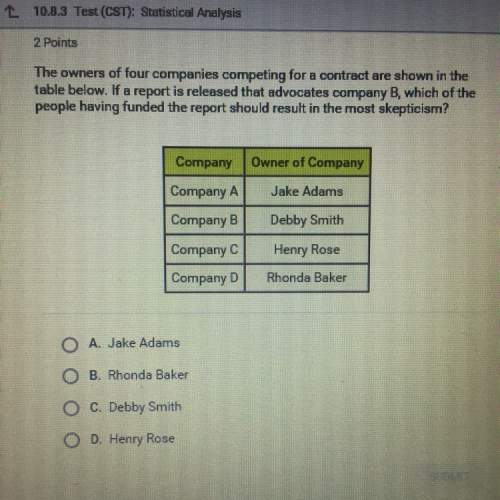
Mathematics, 03.10.2019 01:00, ansuaprajita1506
Biochemists studying enzyme kinetics encounter formulas of the form fx) = (k/v)x+1/v, where (a) if f(x) 0.6x + 20, find k and v so that f(x) may be written in the form f(x) = (k/v)x+ 1/v. (b) find the x-intercept and y-intercept of the line y = (k/v)x+1/v (in terms of k and v). (a) k-0 (simplify your answer. type an integer or a fraction) 1 r i more vi check antwer enter your answer in the answer box and then click check answer. clear all v uestion 3 parts question 9 remaining v question ad p 11/2019 questions

Answers: 1
Other questions on the subject: Mathematics


Mathematics, 21.06.2019 15:30, 001234567891011
Abike shop sells you a bicycle for $63 and a helmet for $21. the total cost is 150% of what the shop spent originally. how much did the shop spend originally? how much profit did the bike shop earn by selling the bicycle and helmet to you ?
Answers: 1

Mathematics, 21.06.2019 21:30, gonzalezashley152
In a test for esp (extrasensory perception), the experimenter looks at cards that are hidden from the subject. each card contains either a star, a circle, a wave, a cross or a square.(five shapes) as the experimenter looks at each of 20 cards in turn, the subject names the shape on the card. when the esp study described above discovers a subject whose performance appears to be better than guessing, the study continues at greater length. the experimenter looks at many cards bearing one of five shapes (star, square, circle, wave, and cross) in an order determined by random numbers. the subject cannot see the experimenter as he looks at each card in turn, in order to avoid any possible nonverbal clues. the answers of a subject who does not have esp should be independent observations, each with probability 1/5 of success. we record 1000 attempts. which of the following assumptions must be met in order to solve this problem? it's reasonable to assume normality 0.8(1000), 0.2(1000)%30 approximately normal 0.8(1000), 0.2(1000)% 10 approximately normal srs it is reasonable to assume the total number of cards is over 10,000 it is reasonable to assume the total number of cards is over 1000
Answers: 1
Do you know the correct answer?
Biochemists studying enzyme kinetics encounter formulas of the form fx) = (k/v)x+1/v, where (a) if f...
Questions in other subjects:


Computers and Technology, 19.05.2021 17:20

Mathematics, 19.05.2021 17:20

Physics, 19.05.2021 17:20

Mathematics, 19.05.2021 17:20

Mathematics, 19.05.2021 17:20


Chemistry, 19.05.2021 17:20


Mathematics, 19.05.2021 17:20








